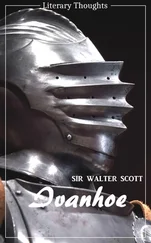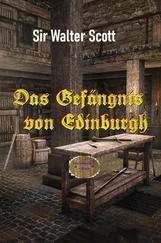Walter Scott - Ivanhoe
Здесь есть возможность читать онлайн «Walter Scott - Ivanhoe» — ознакомительный отрывок электронной книги совершенно бесплатно, а после прочтения отрывка купить полную версию. В некоторых случаях можно слушать аудио, скачать через торрент в формате fb2 и присутствует краткое содержание. Жанр: Исторические приключения, на английском языке. Описание произведения, (предисловие) а так же отзывы посетителей доступны на портале библиотеки ЛибКат.
- Название:Ivanhoe
- Автор:
- Жанр:
- Год:неизвестен
- ISBN:нет данных
- Рейтинг книги:4 / 5. Голосов: 1
-
Избранное:Добавить в избранное
- Отзывы:
-
Ваша оценка:
- 80
- 1
- 2
- 3
- 4
- 5
Ivanhoe: краткое содержание, описание и аннотация
Предлагаем к чтению аннотацию, описание, краткое содержание или предисловие (зависит от того, что написал сам автор книги «Ivanhoe»). Если вы не нашли необходимую информацию о книге — напишите в комментариях, мы постараемся отыскать её.
Ivanhoe — читать онлайн ознакомительный отрывок
Ниже представлен текст книги, разбитый по страницам. Система сохранения места последней прочитанной страницы, позволяет с удобством читать онлайн бесплатно книгу «Ivanhoe», без необходимости каждый раз заново искать на чём Вы остановились. Поставьте закладку, и сможете в любой момент перейти на страницу, на которой закончили чтение.
Интервал:
Закладка:
CHAPTER XVIII
1 (p. 183) epigraph: This epigraph begins a sequence of invented verse passages authored by Scott himself to serve as epigraphs in Ivanhoe. Scott was in a hurry to finish the novel, needing the money from its sales to purchase a commission in the army for his son. There is no better evidence of his haste than his choosing to invent epigraphs rather than go to the trouble of remembering and locating an appropriate verse or passage.
2 (p. 190) Hotspur: Scott refers to the scene in Shakespeare’s 1 Henry IV in which Hotspur is frustrated by a reluctant and sluggish ally, Archbishop Scroop (act 3, scene 1).
CHAPTER XIX
1 (p. 191) epigraph: The lines are from Baillie’s Orra: A Tragedy (1812; act 3, scene 1).
CHAPTER XX
1 (p. 198) epigraph: The lines are written by Scott.
2 (p. 198) Watling Street: This is the English name for the old Roman road that runs south-north from Dover through London to the northern border.
3 (p. 200) De profundis clamavi: See the Bible, Psalm 130:1, “Out of the depths have I cried unto thee, O Lord” (King James Version; henceforth, KJV).
CHAPTER XXI
1 (p. 205) epigraph: The lines are from Baillie’s Orra (act 3, scene 2).
2 (p. 209) Tosti … the tale: Tosti was King Harold II’s disgruntled brother who, with encouragement from William of Normandy, allied himself to an invading Norwegian force and launched an attack on the King’s forces at Stamford Bridge near York in September 1066. The Norwegians were defeated, and Tosti was killed. Harold was celebrating the victory when word came of the Norman invasion in the south. Harold immediately marched his army to meet William but was defeated and shot dead with an arrow in the eye on October 14 at the Battle of Hastings.
3 (p. 210) the bloody streams of the Derwent: [Author’s note] Battle of Stamford. A great topographical blunder occurred here in former editions. The bloody battle alluded to in the text, fought and won by King Harold, over his brother the rebellious Tosti, and an auxiliary force of Danes or Norsemen, was said, in the text and a corresponding note, to have taken place at Stamford, in Leicestershire [Lincolnshire], and upon the river Welland. This is a mistake into which the Author has been led by trusting to his memory, and so confounding two places of the same name. The Stamford, Strangford, or Staneford at which the battle really was fought is a ford upon the river Derwent, at the distance of about seven [nine] miles from York, and situated in that large and opulent county. A long wooden bridge over the Derwent, the site of which, with one remaining buttress, is still shown to the curious traveller, was furiously contested. One Norwegian long defended it by his single arm, and was at length pierced with a spear thrust through the planks of the bridge from a boat beneath.
The neighbourhood of Stamford, on the Derwent, contains some memorials of the battle. Horse-shoes, swords, and the heads of halberds, or bills, are often found there; one place is called the “Danes’ well,” another the “Battle flats.” From a tradition that the weapon with which the Norwegian champion was slain resembled a pear, or, as others say, that the trough or boat in which the soldier floated under the bridge to strike the blow had such a shape, the country people usually begin a great market which is held at Stamford with an entertainment called the Pear-pie feast, which, after all, may be a corruption of the Spear-pie feast. For more particulars, Drake’s History of York may be referred to. The Author’s mistake was pointed out to him, in the most obliging manner, by Robert Belt, Esq., of Bossal House. The battle was fought in 1066.
4 (p. 213) the destined knight: Possibly a reference to a scene in Ariosto’s Orlando Furioso (22.18-23) where Astolfo blows his horn to warn the inhabitants of an enchanted castle, which then disappears into mist.
CHAPTER XXII
1 (p. 213) epigraph: The lines are from Shakespeare’s The Merchant of Venice (act 2, scene 8).
2 (p. 216) the keys … to bind and to loose: The reference is to the keys to the kingdom of heaven, as noted in the Bible, Matthew 16:19.
3 (p. 217) “above that glowing charcoal”: [Author’s note] Torture. This horrid species of torture may remind the reader of that to which the Spaniards subjected Guatemozin, in order to extort a discovery of his concealed wealth. But, in fact, an instance of similar barbarity is to be found nearer home, and occurs in the annals of Queen Mary’s time, containing so many other examples of atrocity. Every reader must recollect that, after the fall of the Catholic Church, and the Presbyterian Church government had been established by law, the rank, and especially the wealth, of the bishops, abbots, priors, and so forth, were no longer vested in ecclesiastics, but in lay impropriators of the church revenues, or, as the Scottish lawyers called them, titulars of the temporalities of the benefice, though having no claim to the spiritual character of their predecessors in office.
Of these laymen who were thus invested with ecclesiastical revenues, some were men of high birth and rank, like the famous Lord James Stuart, the prior of St. Andrews, who did not fail to keep for their own use the rents, lands, and revenues of the church. But if, on the other hand, the titulars were men of inferior importance, who had been inducted into the office by the interest of some powerful persons, it was generally understood that the new abbot should grant for his patron’s benefit such leases and conveyances of the church lands and tithes as might afford their protector the lion’s share of the booty. This was the origin of those who were wittily termed Tulchan Bishops, gxbeing a sort of imaginary prelate, whose image was set up to enable his patron and principal to plunder the benefice under his name.
There were other cases, however, in which men who had got grants of these secularised benefices were desirous of retaining them for their own use, without having the influence sufficient to establish their purpose; and these became frequently unable to protect themselves, however unwilling to submit to the exactions of the feudal tyrant of the district.
Bannatyne, secretary to John Knox, recounts a singular course of oppression practised on one of those titular abbots by the Earl of Cassilis, in Ayrshire, whose extent of feudal influence was so wide that he was usually termed the King of Carrick. We give the fact as it occurs in Bannatyne’s Journal [pp. 55—67], only premising that the Journalist held his master’s opinions, both with respect to the Earl of Cassilis as an opposer of the king’s party, and as being a detester of the practice of granting church revenues to titulars, instead of their being devoted to pious uses, such as the support of the clergy, expense of schools, and the relief of the national poor. He mingles in the narrative, therefore, a well-deserved feeling of execration against the tyrant who employed the torture, with a tone of ridicule towards the patient, as if, after all, it had not been ill-bestowed on such an equivocal and amphibious character as a titular abbot. He entitles his narrative
THE EARL OF CASSILIS’ TYRANNY AGAINST A QUICK
(i.e. LIVING) MAN
“Master Allan Stewart, friend to Captain James Stewart of Cardonall, by means of the Queen’s corrupted court, obtained the abbacy of Crossraguel. The said Earl, thinking himself greater than any king in those quarters, determined to have that whole benefice (as he hath divers others) to pay at his pleasure; and because he could not find sic security as his insatiable appetite required, this shift was devised. The said Mr. Allan, being in company with the Laird of Bargany, was, by the said Earl and his friends, enticed to leave the safeguard which he had with the said Laird, and come to make good cheer with the said Earl. The simplicity of the imprudent man was suddenly abused; and so he passed his time with them certain days, which he did in Maybole with Thomas Kennedie, uncle to the said Earl; after which the said Mr. Allan passed, with quiet company, to visit the place and bounds of Crossraguel, of which the said Earl being surely advertised, determined to put in practice the tyranny which long before he had conceived. And so, as king of the country, apprehended the said Mr. Allan, and carried him to the house of Dunure, where for a season he was honourably treated (gif a prisoner can think any entertainment pleasing); but after that certain days were spent, and that the Earl could not obtain the feus of Crossraguel according to his awin appetite, he determined to prove gif a collation could work that which neither dinner nor supper could do for a long time. And so the said Mr. Allan was carried to a secret chamber; with him passed the honourable Earl, his worshipful brother, and such as were appointed to be servants at that banquet. In the chamber there was a grit iron chimlay, under it a fire; other grit provision was not seen. The first course was—‘My Lord Abbot,’ said the Earl, ‘it will please you confess here, that with your own consent you remain in my company, because ye durst not commit yourself to the hands of others.’ The Abbot answered, ‘Would you, my lord, that I should make a manifest lie for your pleasure? The truth is, my lord, it is against my will that I am here; neither yet have I any pleasure in your company.’ ‘But ye shall remain with me at this time,’ said the Earl. ‘I am not able to resist your will and pleasure,’ said the Abbot, ‘in this place.’ ‘Ye must then obey me,’ said the Earl; and with that were presented unto him certain letters to subscribe, amongst which there was a five year tack, and a nineteen year tack, and a charter of feu of all the lands of Crossraguel, with all the clauses necessary for the Earl to haste him to hell. For gif adultery, sacrilege, oppression, barbarous cruelty, and theft heaped upon theft, deserve hell, the great King of Carrick can no more escape hell for ever than the imprudent Abbot escaped the fire for a season as follows.
Читать дальшеИнтервал:
Закладка:
Похожие книги на «Ivanhoe»
Представляем Вашему вниманию похожие книги на «Ivanhoe» списком для выбора. Мы отобрали схожую по названию и смыслу литературу в надежде предоставить читателям больше вариантов отыскать новые, интересные, ещё непрочитанные произведения.
Обсуждение, отзывы о книге «Ivanhoe» и просто собственные мнения читателей. Оставьте ваши комментарии, напишите, что Вы думаете о произведении, его смысле или главных героях. Укажите что конкретно понравилось, а что нет, и почему Вы так считаете.








